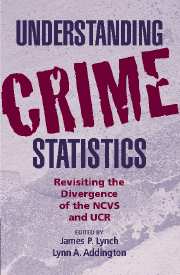Crossref Citations
This Book has been
cited by the following publications. This list is generated based on data provided by Crossref.
Seow, Christopher
Barton, Harry
and
Beynon, Malcolm J.
2011.
Targeted criteria performance improvement.
International Journal of Public Sector Management,
Vol. 24,
Issue. 4,
p.
356.
Dayan, Jacques
2012.
Comprendre la délinquance ?.
Adolescence,
Vol. T. 30 n°4,
Issue. 4,
p.
881.
Matusitz, Jonathan
and
Breen, Gerald-Mark
2013.
Applying Inoculation Theory to the Study of Recidivism Reduction in Criminal Prison Inmates.
Journal of Evidence-Based Social Work,
Vol. 10,
Issue. 5,
p.
455.
Birkel, Christoph
2014.
Empirische Forschung über Kriminalität.
p.
67.
Harding, David
and
Winship, Christopher
2016.
Population Growth, Migration, and Changes in the Racial Differential in Imprisonment in the United States, 1940–1980.
Social Sciences,
Vol. 5,
Issue. 3,
p.
32.
BRANTINGHAM, P. JEFFREY
2016.
CRIME DIVERSITY*.
Criminology,
Vol. 54,
Issue. 4,
p.
553.
Pfeffer, Rebecca
and
Cuevas, Carlos A.
2016.
The Wiley Handbook on the Psychology of Violence.
p.
715.
Xie, Min
and
Lynch, James P.
2017.
The Effects of Arrest, Reporting to the Police, and Victim Services on Intimate Partner Violence.
Journal of Research in Crime and Delinquency,
Vol. 54,
Issue. 3,
p.
338.
Lugo-Ocando, Jairo
2017.
Crime Statistics in the News.
p.
151.
Brame, Robert
Turner, Michael G.
and
Paternoster, Raymond
2017.
Surveying Residential Burglaries: A Case Study of Local-Level Crime Measurement.
Criminal Justice Policy Review,
Vol. 28,
Issue. 9,
p.
918.
Pyrooz, David C.
LaFree, Gary
Decker, Scott H.
and
James, Patrick A.
2018.
Cut from the Same Cloth? A Comparative Study of Domestic Extremists and Gang Members in the United States.
Justice Quarterly,
Vol. 35,
Issue. 1,
p.
1.
Andersson, Catrin
and
Kazemian, Lila
2018.
Reliability and validity of cross-national homicide data: a comparison of UN and WHO data.
International Journal of Comparative and Applied Criminal Justice,
Vol. 42,
Issue. 4,
p.
287.
Legewie, Joscha
2018.
Living on the Edge: Neighborhood Boundaries and the Spatial Dynamics of Violent Crime.
Demography,
Vol. 55,
Issue. 5,
p.
1957.
Wormeli, Paul
2018.
Criminal Justice Statistics—An Evolution.
Criminology & Public Policy,
Vol. 17,
Issue. 2,
p.
483.
Stacey, Michele
Averett, Paige
and
Knox, Brianna
2018.
An Exploration of Victimization in the Older Lesbian Population.
Victims & Offenders,
Vol. 13,
Issue. 5,
p.
693.
Legewie, Joscha
and
Fagan, Jeffrey
2019.
Aggressive Policing and the Educational Performance of Minority Youth.
American Sociological Review,
Vol. 84,
Issue. 2,
p.
220.
Van Dijk, Jan
2019.
The Palgrave International Handbook of Human Trafficking.
p.
1.
Tregle, Brandon
Nix, Justin
and
Alpert, Geoffrey P.
2019.
Disparity does not mean bias: making sense of observed racial disparities in fatal officer-involved shootings with multiple benchmarks.
Journal of Crime and Justice,
Vol. 42,
Issue. 1,
p.
18.
Ngo, Fawn T.
2020.
Stalking Victimization: Examining the Impact of Police Action and Inaction on Victim-Reported Outcome.
Journal of Police and Criminal Psychology,
Vol. 35,
Issue. 2,
p.
146.
Van Dijk, Jan
2020.
The Palgrave International Handbook of Human Trafficking.
p.
1671.



